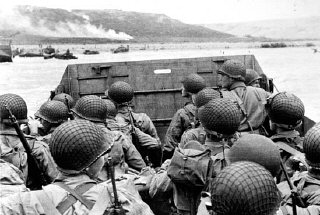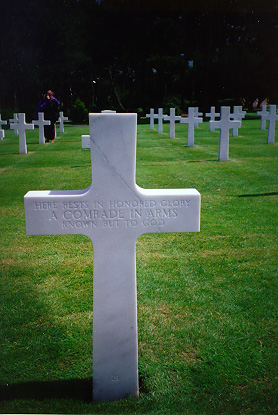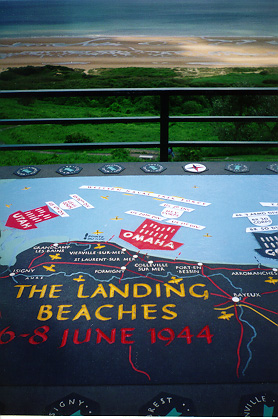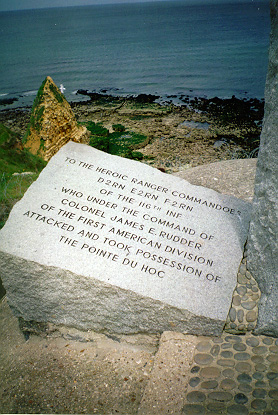|
Follow
Us New
& Recent Conflicts
War
and Conflict
Links Portal
for pages on the history of
comics and superhero
characters Portal
for pages on the nations of the
world Portal
for pages on military history Lists
of wars throughout history and
from around the world Biographical
files on individuals who impact
American politics, culture,
business, education and other
arenas of life in the United
States. Pages
on the governmental systems of
selected nations. United
States national government and
politics. The
latest changes to the History Guy
site. Information
on the History Guy, the origin of
the website, along with
commentaries
and a site
map. Copyright
© 1998-2013 Roger A. Lee and History
Guy Media; Last Modified:
05.05.13 "The
History Guy" is a Registered
Trademark. |
World
War 2: The Invasion of
Normandy (1944)
A
brief summary of the Normandy
Invasion: At
the beginning of World War 2, Germany
invaded Poland, causing France, Great
Britain and Canada to declare war on
Germany. By the spring of 1940, the German
army was ready to invade France, defended
by not only the French military, but also
a sizable British force as well. Within
six weeks, the Germans defeated the Allies
and seized control of France. By 1944, the
Germans knew that the Allies, also now
including the United States, among others,
would attempt an invasion of France to
liberate Europe from Germany. The Allied
forces, based in Britain, decided to begin
the invasion by landing a huge army at a
place called Normandy Beach, which is
located on the northwest coast of France.
Code-named "Operation Overlord", and
commanded by American General Dwight D.
Eisenhower, the Allies landed on June 6,
1944 at five beaches in the Normandy area
with the code names of: Utah Beach, Omaha
Beach, Gold Beach, Juno Beach and Sword
Beach. Prior to the actual amphibious
invasion, Allied planes pounded the Nazi
defenders and dropped thousands of
paratroopers behind German lines the night
before the seaborne landings. Local French
Resistance forces, alerted to the imminent
invasion, engaged in behind-the-lines
sabotage and combat against the occupying
Germans. 156,000
American, British and Canadian troops met
heavy resistance from the German forces
defending the area, but were able to punch
inland, securing safe landing zones for
reinforcements. The German failure to
successfully defend the Normandy area from
the Allied liberation forces in essence
doomed Hitler's dream of a Nazi controlled
"Fortress Europe" and marked the beginning
of the end for Germany. The
exact number of men on both sides who died
that day will probably never truly be
known. Different sources cite different
numbers of Allied, U.S. and German
casualties: --The
Heritage Foundation in the U.S. claims
4,900 U.S. dead on D-Day --The
U.S. Army Center of Military History
cites a total casualty figure for U.S.
forces at 6,036. This number combines
dead and wounded in the D-Day
battles --John
Keegan, American Historian and Author
believes that 2,500 Americans died
along with 3,000 British and Canadian
troops on D-Day By
the end of the of the entire Normandy
Campaign, nearly 425,000 Allied and German
troops were killed, wounded, or
missing. Purdue
and Indiana University researchers are
commemorating the 65th anniversary of
D-Day by releasing the first version of a
3-D, interactive model of the Omaha Beach
battlefield.--Purdue
and Indiana University researchers are
commemorating the 65th anniversary of
D-Day by releasing the first version of a
3-D, interactive model of the Omaha Beach
battlefield. American
Battle Monuments
Commission-
the homepage for the American Battle
Monuments Commission. Comprehensive
information about the war cemeteries,
memorials, etc. that are administered by
the ABMC. A complete listing of all
American war cemeteries on foreign soil
with corresponding information can be
found here. American
Experience, The: Guts and
Glory
- first-hand stories and strategies behind
two monumental World War II events: the
D-Day invasion and the Battle of the
Bulge. The
Caen Memorial-A Museum for
Peace
- an excellent source for information on
World War II, D-Day and the battle for
Normandy. Located in Caen,
Normandy.
*I have been to this museum. It
is a fabulously modern information center!
I highly recommend it to anyone visiting
the Normandy area.* Desperate
Battle: Normandy
1944
- based in part on the documentary, The
Valour & The Horror - Canada At War.
Explores Canada's involvement in World War
II. National
D-Day Memorial Foundation Normandy
Allies
- non-profit organization which
commemorates the liberation of Normandy in
1944. Offering a summer study trip
designed to educate students about this
historic and monumental feat. Normandy:
1944
- offers a virtual march through the World
War II invasion by means of photos,
articles and essays, interactive maps,
audio and video clips, and transcripts of
first-person accounts. Excellent
site! Omaha
Beach D-Day
account of LTC John G.
Burkhalter
- personal account of D-day on Omaha Beach
as part of the Big Red One. D-Day
memories of Jim
Wilkins
- Jim Wilkins was with The Queen's Own
Rifles of Canada, Company B. First
Wave at Omaha Beach
- from the Atlantic Monthly. Map
of the Beach
Assault
- indicating the location of the defensive
positions and where the Allied Forces
landed. Normandy:
1944 -- Omaha Beach
- from Britannica Online. Omaha
Beachhead 6 June - 13 June
1944
- from the American Forces in Action
Series Historical Division War
Department. The
29th Infantry
Division--Information
on a U.S. Army division at Omaha
Beach. World
War II Buddy--Memoirs
of Albert J. Yascavage, a disabled United
States combat veteran of WWII who landed
at Omaha Beach. He wants to hear from
former soldiers of the Second Signal
Company - Second Infantry Division, and
former members of the 109th Field
Artillery - 28th Infantry Division. This
page is designed to tell the stories of
World War II vets. The
History Guy®: The Raid at Dieppe
(1942)--
Page containing links to the costly Allied
raid on the Frech town of Dieppe in
1942. "The
History Guy" is a Registered Trademark. Contact
the webmaster |
Video footage of Allied
D-Day Normandy Landings in World War
Two Historyguy.com Search
Engine
Trending on
Historyguy.com Now: Join the
FREE Historyguy Update list. Receive regular
updates delivered right to your
inbox.
Email
Marketing You Can Trust Photographs
Copyright © 1997 Roger A. Lee An
Unknown Soldier's Grave at the American Cemetary at
Normandy. A
map of the invasion at Normandy, with the landing
beach in the background. A
monument to the bravery of the American Rangers who
took Pointe Du Hoc fromt the Germans on
D-Day. |
|||||||||




